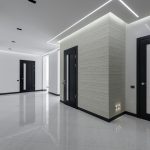Innovative Design Techniques for Laundry Area Integration
Clever laundry integration in kitchens has become a crucial aspect of modern home design, offering practical space-saving solutions without compromising aesthetics. This approach encourages the incorporation of integrated laundry appliances, such as washer-dryer combos, directly into the kitchen or adjacent spaces.
One effective method is utilizing multifunctional furniture. This can involve cabinets that serve dual purposes, such as housing both kitchen essentials and laundry storage. Additionally, incorporating built-in appliances ensures seamless alignment with the surrounding kitchen design, maintaining a clean and organized look. This strategy not only optimizes the use of space but also enhances the overall functionality of the kitchen.
Additional reading : Unlocking the secrets to reviving stained glass in historic uk homes: expert tips and professional guidance
Designated zones can be created by subtly partitioning areas, perhaps with the use of clever shelving or sliding doors. These solutions enable the kitchen and laundry functions to coexist harmoniously, ensuring that neither area feels cramped or cluttered. By focusing on clever space utilization, it is possible to have a functional laundry area that integrates perfectly into the kitchen setting.
Innovative Design Techniques for Laundry Area Integration
Achieving seamless integration between the kitchen and laundry areas requires innovative design techniques that prioritize space-saving solutions and maintain cohesive aesthetics. When considering compact appliances, options such as a washer-dryer combo are essential for maximizing limited space. These appliances efficiently perform dual functions without consuming excess room, ideal for smaller kitchens.
Also to read : Transform your uk garden into a serene sensory oasis: the ultimate guide to home relaxation
Utilizing multifunctional furniture plays a pivotal role in these settings. For example, incorporating wall-mounted shelves not only frees up valuable floor space but also provides additional storage for both kitchen and laundry essentials. Similarly, foldable laundry drying racks that can be tucked away when not in use offer practical solutions to those with spatial constraints.
Moreover, thoughtful layout strategies, such as creating designated zones within the kitchen, enable different areas to be used effectively without interfering with one another. This can be achieved through clever use of vertical space, like installing cabinets that reach the ceiling, offering ample storage while keeping everything organized and accessible.
These design tactics ensure that even within compact environments, the practicality of having a laundry area integrated into the kitchen does not come at the cost of design integrity or functionality.
## Space-Saving Tips for Small Kitchens
In small kitchens, every inch of space counts, which makes **clever laundry integration** a necessity. By choosing compact appliances and employing efficient design strategies, homeowners can maintain both functionality and style in their limited spaces.
### Choosing Compact Appliances
When integrating laundry into a small kitchen, selecting **compact appliances** is crucial. **Washer-dryer combos** serve a dual purpose, minimizing the footprint and leaving more room for other kitchen essentials. These appliances are vital for maximizing both **space and functionality**. In addition, opting for models designed specifically for small spaces can further enhance the overall efficiency of the kitchen area, ensuring all tasks are accommodated without feeling cramped.
### Utilizing Vertical Space
Vertical space is often overlooked but offers great potential for **efficient use of space**. Installing wall-mounted shelves or tall cabinets not only provides additional storage but also keeps the floor clear. With the clever use of height, kitchens can remain uncluttered and stylish, offering access to essentials while supporting the overall design theme. Thus, utilizing vertical dimensions effectively contributes significantly to the harmonious integration of laundry facilities.
### Folding Solutions and Hidden Storage
For those dealing with limited space, incorporating foldable solutions is a game-changer. **Folding laundry racks** are ideal as they can be brought out only when needed and neatly tucked away afterward. Hidden storage options, such as pull-out ironing boards, further the utility without infringing on the kitchen's aesthetic. These innovations emphasize the importance of smart storage strategies, encouraging a tidy and organized space that facilitates a seamless transition between various kitchen activities.
Design Examples and Inspiration
For homeowners seeking kitchen laundry design inspiration, modern solutions incorporate both function and aesthetics. One popular approach involves a creative layout that utilizes hidden appliances, creating visual harmony. This technique allows laundry areas to be seamlessly integrated into the kitchen space without disrupting the clean lines often associated with modern interiors.
Incorporating modern aesthetics into these designs can be achieved through sleek cabinetry that matches the kitchen’s existing décor. Selecting similar materials for both kitchen and laundry areas ensures a unified look. For instance, using the same countertop material for a workstation next to a washer-dryer combo maintains design continuity.
Case studies from the UK highlight examples where functionality and style merge successfully. Many designs cleverly position appliances behind sliding or pocket doors, rendering the laundry area invisible when not in use. This not only conserves space but also aligns with contemporary minimalist trends. Such kitchen laundry designs underscore the possibility of achieving a practical and visually appealing setup that meets the demands of modern living.
By drawing from these design inspiration examples, you can envision a space that blends style and utility, ensuring your kitchen’s functionality is maximized without sacrificing its aesthetic appeal.
Addressing Common Challenges
Integrating a laundry area into the kitchen comes with its unique kitchen challenges. One major issue is the limitation of space, particularly in urban settings where every square meter counts. Residents often find it difficult to fit both appliances and daily kitchen necessities without feeling cramped. Finding creative ways to incorporate clever laundry integration techniques, such as using multifunctional furniture, can help to make the most of available space.
Another common challenge is dealing with noise and vibration from appliances. Design barriers can be overcome by selecting quieter units designed for reduced vibration, and installing soundproofing materials can minimize disturbances in open-plan kitchen spaces. Proper placement and padding for appliances are crucial to addressing these concerns effectively.
Managing ventilation and plumbing requirements is also key in ensuring space-saving solutions do not compromise practicality. Adequate ventilation prevents moisture build-up and maintains air circulation, which can be addressed by installing extractor fans or leaving space for air to flow. Ensuring existing plumbing can handle the integration of a laundry area is a critical step, requiring thoughtful layout planning and sometimes professional advice.
By proactively managing these laundry area problems, homeowners can achieve seamless integration and maintain both function and aesthetics in their kitchen spaces.
Aesthetic Considerations for Seamless Integration
In the pursuit of a seamless blend between kitchen and laundry spaces, focusing on design aesthetics ensures harmony and functionality. By considering cohesive style and thoughtfully appropriating color schemes, homeowners can elevate these areas into harmonious parts of a modern home.
Matching Materials and Finishes
To achieve a cohesive style, begin by selecting cabinetry and finishes that effortlessly integrate with existing kitchen decor. This might involve choosing materials like wood or metal that are already prevalent in your kitchen. Maintaining consistency in surface finishes, such as glossy or matte, across both kitchen and laundry sections helps unify the visual flow, making these spaces appear as a single, coordinated unit.
Color Theory in Kitchen-Laundry Design
The strategic use of color schemes can further unify your design. Employ color theory by selecting a palette that complements both areas. Neutral tones, such as whites and greys, provide a timeless backdrop, while bolder hues can highlight distinct sections. By echoing a similar color palette throughout, the boundary between kitchen and laundry zones becomes blurred, enhancing the integrated feel.
Lighting Solutions for Laundry Areas
Lighting plays an indispensable role in achieving both functionality and style. Integrating task lighting can highlight work areas in the laundry section, ensuring practical illumination for chores. Similarly, ambient lighting can enhance the overall atmosphere, fostering a warm and inviting environment. Choose fixtures that blend with the general kitchen theme, whether they are contemporary pendants or subtle under-cabinet LEDs, to maintain a consistent aesthetic.
Adopting these design aesthetics principles, you ensure that your kitchen and laundry coexist not just physically, but visually and atmospherically, offering both practicality and aesthetic appeal in a seamlessly integrated space.



